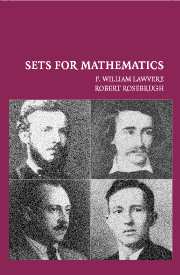Book contents
- Frontmatter
- Contents
- Foreword
- Contributors to Sets for Mathematics
- 1 Abstract Sets and Mappings
- 2 Sums, Monomorphisms, and Parts
- 3 Finite Inverse Limits
- 4 Colimits, Epimorphisms, and the Axiom of Choice
- 5 Mapping Sets and Exponentials
- 6 Summary of the Axioms and an Example of Variable Sets
- 7 Consequences and Uses of Exponentials
- 8 More on Power Sets
- 9 Introduction to Variable Sets
- 10 Models of Additional Variation
- Appendixes
- A Logic as the Algebra of Parts
- B The Axiom of Choice and Maximal Principles
- C Definitions, Symbols, and the Greek Alphabet
- Bibliography
- Index
B - The Axiom of Choice and Maximal Principles
Published online by Cambridge University Press: 06 July 2010
- Frontmatter
- Contents
- Foreword
- Contributors to Sets for Mathematics
- 1 Abstract Sets and Mappings
- 2 Sums, Monomorphisms, and Parts
- 3 Finite Inverse Limits
- 4 Colimits, Epimorphisms, and the Axiom of Choice
- 5 Mapping Sets and Exponentials
- 6 Summary of the Axioms and an Example of Variable Sets
- 7 Consequences and Uses of Exponentials
- 8 More on Power Sets
- 9 Introduction to Variable Sets
- 10 Models of Additional Variation
- Appendixes
- A Logic as the Algebra of Parts
- B The Axiom of Choice and Maximal Principles
- C Definitions, Symbols, and the Greek Alphabet
- Bibliography
- Index
Summary
The axiom of choice was first formulated by Zermelo in 1904 and used to prove his Well-Ordering theorem. The axiom was considered controversial because it introduced a highly nonconstructive aspect that differed from other axioms of set theory. For some time it was mainly used in the form of the Well-Ordering theorem (which is actually equivalent to the choice axiom). In this formulation, the axiom permits arguments by the so-called transfinite induction. For about the last 50 years it has usually been used in the form of the Maximal Principle of Zorn (published in the 1930s, though a version by Hausdorff was published earlier.)
If nontrivial variation with respect to some category S of abstract sets and arbitrary mappings is allowed in a category of variable sets, the axiom of choice tends not to hold as we have seen in Exercises 4.54, 6.12, and Section 10.3. In fact, the axiom is valid in certain very special toposes of variable sets determined relative to a category of abstract sets and arbitrary mappings, as was mentioned in Section 4.6.
Here we will demonstrate that Zorn's Maximal Principle is equivalent to the axiom of choice. We will show this for forms of the Maximal Principle that use both chains and directed (or filtered) posets. The latter form is more suitable for arguments made in mathematical practice, whereas it is the former that we will see as a direct consequence of the axiom of choice. In addition we will consider Hausdorff's Maximal Principle and some other consequences of the choice axiom. Our proofs of the maximal principles will follow directly from the famous Fixed- Point theorem of Bourbaki (B.15 below).
- Type
- Chapter
- Information
- Sets for Mathematics , pp. 220 - 230Publisher: Cambridge University PressPrint publication year: 2003

